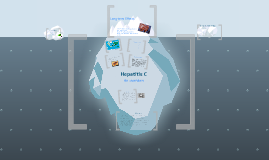Hepatitis C
Transcript: Treatment and Prevention History Single strand, positive-sense RNA virus with 7 genotypes Infects hepatocytes with rapid, mutation prevalent replication 60-70% of those infected develop some form of liver disease Up to 20% will develop Cirrhosis Up to 5% of will die from cirrhosis or liver cancer "Hepatitis C Information for the Public". Centers for Disease Control and Prevention (CDC). October 22 2012. Choo QL, Kuo G, Weiner AJ, Overby LR, Bradley DW, Houghton M. Isolation of a cDNA clone derived from a bloodborne non-A, non-B viral hepatitis genome. Science 1989;244:359–362. Silvestri F, Barillari G, Fanin R, et al. Risk of hepatitis C virus infection, Waldenstrom’s macroglobulinemia, and monoclonal gammopathies. Blood 1996; 88:1125–1126. National Institutes of Health. National Institutes of Health Consensus Development Conference Statement: Management of hepatitis C: 2002—June 10–12, 2002. Hepatology 2002 Alter MJ, Kruszon-Moran D, Nainan OV, et al. The prevalence of hepatitis C virus infection in the United States, 1988 through 1994. N Engl J Med 1999; 341:556–562. Worldwide Hepatitis C Prevalence Hepatitis C Before 1989, its existence had not been proven. Known as "non-A" "non-B" up until 1970's through transfusion experiments Cloning and isolation of genome through collaboration between Chiron Corp. and the CDC led to its discovery in 1989 Chronic and widespread infection among the world population confirmed Linked to cirrhosis, liver failure and hepatocellular carcinoma Research: A Possible Cure Although short term symptoms are rare, they can include: fever fatigue loss of appetite nausea vomiting abdominal pain dark urine joint pain jaundice clay-colored bowel movements Virology My research in Dr. Stephen F. Martin's lab is but one of many attempts to prevent HCV replication I study the thermodynamic properties of protein ligand interactions with the NS3 Protein The NS3 protein is an autoprotease that is vital to the processing step of replication after translation Treatment still limited to general antiviral drugs like ribavirin and pegylated interferon alpha. Approximately 50-60% of people have improved outcomes with this treatment. Unfortunately, half the patients undergoing this drug therapy experience flu like symptoms, with a third experiencing altered emotional states (mood swings, irritability, and depression). Unlike Hepatitis A and B, there is currently no vaccine An overview References Epidemiology and Statistics Long-term Effects Estimated 200 million (2-3% population) infected with Hepatitis C Hepatitis C classified as either acute or chronic. With less than 1% of people experiencing acute symptoms. 15-25% of those exposed successfully fight off the virus, while 75-85% have the chronic infection. (Ex: 3.2 million in the United States) Over 80% cases are asymptomatic; not recognized until liver damage is present Published January 27, 2012 Spread occurs primarily by sharing equipment for drug injections or from mother to child (4% chance) Sexual contact and accidental blood-blood transmission is possible but rare It can survive outside of a host for 16 hours to 4 days Those infected with HIV, and older patients who received hemodialysis or blood-clotting treatments are also at risk Acute Symptoms and Spread

















